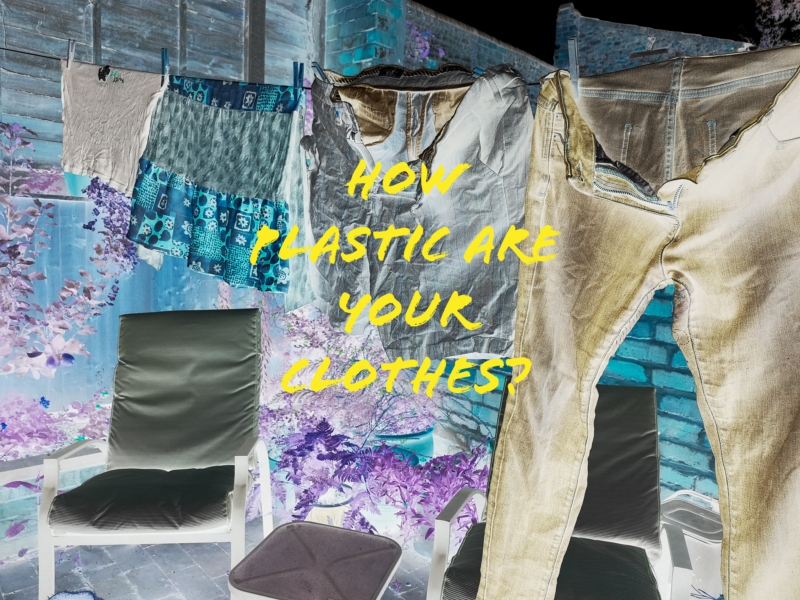Microfibre pollution has been on my mind again recently as I’ve been making clothes and have been fabric-focused this summer. I come back round to this in a timely way, as today is the beginning of Zero Waste Week.
The theme for this year is cutting your plastic waste. Single-use plastics are the main focus, and are probably the biggest contributor to plastic waste ending up in the ocean. Microfibre pollution, though, from synthetic (plastic!) clothes may not have made it onto your radar quite so much.

I’m a Zero Waste Week Ambassador this week and will be posting about plastic pollution and how a homespun lifestyle can help you to reduce your plastic footprint.
I saw this article in The Guardian recently: Microplastic pollution in oceans is far worse that feared, say scientists. I was surprised to see that the highest levels ever recorded in the world are in a river in Manchester, UK. Even if major floods in the area in 2015 to 2016 were the main cause, it shows just how much microplastic pollution was lurking around in the environment ready to be scooped up in a flood. It has been settling out from land drains onto river floodplains around the country for years. We can trace microfibre pollution back to our washing machines where the fibres are released from our synthetic clothes.
How Plastic are Your Clothes?
Have you ever asked yourself how much plastic is in your wardrobe? How many of your clothes are made from easy-iron polycotton, synthetic fleece, other synthetic t-shirt fabrics and acrylic knitwear? It would be worth considering, because there’s much that you can do to reduce the plastic content of your wardrobe with what you make or buy in the future.
Seek Out Plastic-free and Zero Waste Clothes
It’s occurred to me that the main principles you will see mentioned during Zero Waste Week are all important, where clothing and microfibre pollution are concerned. Refuse, reduce (and repair), reuse, recycle and rot are the watch words.
I’ve heard these words many times before. I thought I knew all about the problems caused by the fast fashion industry. The waste, pollution and social deprivation that textile industry workers endure. That was until I watched True Cost: The movie, which left me speechless. It takes a lot to render me speechless. The footage filmed in an Indian village of people poisoned, and severely disabled by spraying pesticides and herbicides onto to cotton crops, was truly harrowing. I stopped buying new clothes after that, and a few months later I wrote No new clothes: The Seamless Pledge : about the pledge that I’d joined. Gas guzzling clothes gives more insight into the coal-fuelled textile industry.
Knitters even grizzle about nylon in sock wool. Would you ever think about that? The nylon that is in nearly all socks now? If you’re a knitter, you may like my no nylon sock knitting tricks, in No Nylon Socks: Socks for the Future.
I’ve mended, re-purposed and bought second-hand: the approach that all zero wasters would recommend, but it is the end of the refuse, reduce, recycle, rot spectrum that I’ll focus on.
Rot: Go for Biodegradable Natural Fabrics
Here’s to rotters then. Far from outdated, biodegradable natural fabrics are generally beautiful, nice to the touch, and wear well. That’s not too say that synthetics should never make it in to your wardrobe again, but making as many swaps for natural fibres as possible will help to reduce microfibre pollution. Here are two options: make or buy.
Make Your Own
I’m bound to mention making your own clothes. After all, I’ve been a crafter for years, so it’s my natural response. It gives you more freedom. You can choose the fabric or yarn you want, and match it with the style and fit that you want. Plus, you can waste less by creative use of scraps. If you need some motivation to get back to sewing, or even just to start, my last post is about Sewing Motivation Hacks.
Choose natural fabrics such as cotton, linen, hemp, rayon, bamboo, viscose and Tencel™. Although biodegradable, some natural fibres are more sustainable than others. Some (cotton) tend to be grown with heavy use of pesticides, herbicides and water, while others (rayon and bamboo) use harsh chemicals during processing. Ruth Springer gives a good explanation in Eco: Sewing sustainable and re-used materials . Or, listen to Kate Ng on What is sustainable sewing? on the Clothes Making Mavens podcast.
Buy
Not everyone has the crafting instinct, but you don’t have to grapple with knitting needles if that’s not your style. Fortunately, you can buy more sustainable clothes, but you may have to look hard hard in mainstream High Street stores. Have you ever noticed the sea of acrylic, synthetic mock silk, chiffon and leather? The synthetics giving extra stretch to cotton knits? To avoid plastic, we need to go shopping with determination! Finely tune your sense for wool, cotton, linen and hemp, viscose, rayon and bamboo, depending on how absolute you want to be about the sustainability of the fabric.
When you’re done, reuse if possible, then cut the clothes up and rot them on your compost heap.
Try going beyond the High Street to the increasingly popular sustainable clothing brands where you’re more likely to find linen, hemp, organic cotton and wool. However hard you try, though, there are some clothes that are hard to find in natural fabrics.
The Hardest Clothes to Buy Plastic-free
Synthetics reign supreme when it comes to sports, outdoor waterproof wear and underwear. It’s undeniable that synthetics are very useful for wickable, breathable and fully waterproof clothes. Apart from the waterproofs, you can chuck them in the washing machine without much worry. I have two items I’d find hard to give up: my red microfleece and red waterproof jacket.

I cycle a lot and run a little. They’re useful for both. We may have forgotten, though, how useful wool is for warmth in cold weather, coolness in hot weather and breathability.
Maybe natural fibres will make a come back even for these types of clothes, but more on that another time. I started with the end of the refuse, reduce, reuse, recycle, rot spectrum and come back to the the beginning: refuse. Something I keep coming back to is a concept I wrote about recently, in Sustainable Life: Everything has to come from somewhere.
Every Natural Yarn or Fabric Has to Come From Somewhere and Go Somewhere
There is never a perfect solution, but every little helps. You can now buy two washing-aids that are new on the market: a guppyfriend wash bag or a coral ball to catch synthetic fibres in your washing machine. They will probably be hailed as ‘the solution’. You’ll help to reduce ocean pollution but your fibres will go to landfill. It doesn’t change the fact that your synthetic clothes are made from oil – a non-renewable resource. Biodegradable fibres and fabrics, on the other hand, are a renewable resource. So, if you’re really up for greening up your wardrobe, I’m convinced natural fibres are the way to go. As much as is realistic for you.
Even then, there’s a limit to how much we can produce in a sustainable way. After all, how much land can we justify taking up for growing flax, hemp and bamboo to feed fast fashion? Flax, used to make linen, is very hungry for nutrients. So much so, that you’d be advised not to grow flax on the same piece of land for seven years. No wonder medieval farmers used to be made to grow it. Growing any of these crops in large monocultures will also virtually turn any piece of land of land into a wildlife desert.
The answer, along with more sustainable fabrics and fibres, must surely be to come back round to the beginning of the refuse, reduce, reuse, recycle, rot sequence. Buy no new clothes for a while, embrace #slowfashion, enjoy a little creative visible mending. After all, everything comes from somewhere.

